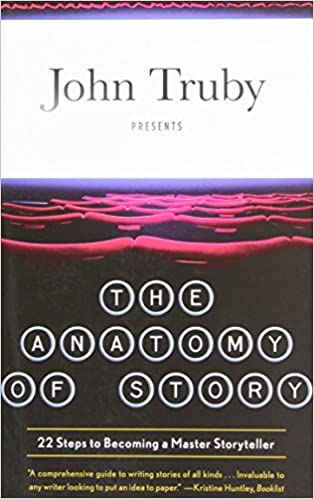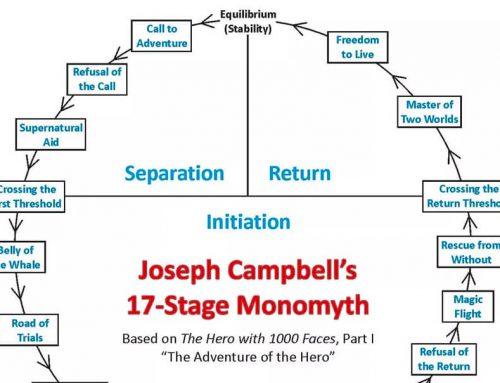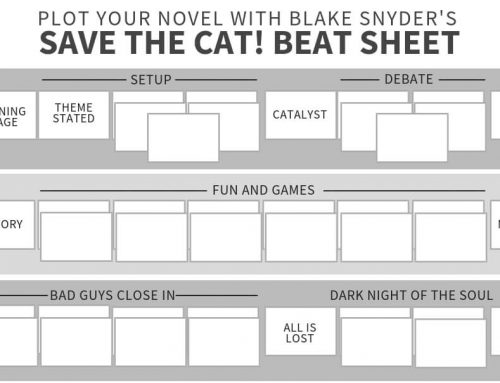
Anatomy of Story: Breakdown of 22 Steps
Ready to get crazy with it? Let's get our Truby on! This was a life changing book for me and I highly recommend it for you.
 Truby is very active in social media. You can find hundreds of hours of video of Truby. He does workshops in Los Angeles, New York and London. If, like me, you are intrigued by his philosophy on plot development, you'll want to follow him on Facebook and visit his website. Maybe one day, I'll see you at a seminar!
Truby is very active in social media. You can find hundreds of hours of video of Truby. He does workshops in Los Angeles, New York and London. If, like me, you are intrigued by his philosophy on plot development, you'll want to follow him on Facebook and visit his website. Maybe one day, I'll see you at a seminar!
Some story plots have another still another layer of complexity. These stories are thoroughly examined in John Truby's The Anatomy of Story. This work is an excellent resource and I reach for it countless times as I write--although I'm not writing an epic, it helps to keep my plots from fraying.
Okay. I'll be honest. This next 3 minute clip is not as exciting. However, it is very good information. Truby has a bucketload of clips on his website, Facebook Page and on You Tube. This one is specific to plot. Again, it's not flashy, but it is very good information for writers. I do highly recommend his book.
I will not pretend to be at Truby's level of story telling sophistication.
I have copied below sections of his book that I feel will give you some footholds and ideas as to how to construct your story using this method. However, I strongly recommend you purchase his book.
Even if you do not intend to use it for your story, it is a fascinating read.I highly recommend you invest in a copy of Truby's book ~ again, even if you are not planning to write an epic. It serves as a great road map for your characters to move through the plot.
Using Truby's 22 steps, even as a sketched outline, will give your plot points intention. The plot points will have a purpose in the arch of your characters.
Below, I listed the the 22 steps. Again this will give you a working idea of what these steps look like and if they feel right to you, you'll want to know get the book. Following the 22 steps, I also dive into the Moral Dilemma outline for you.
The 22 Steps:
- Self-revelation, need, and desire
- Ghost and story world
- Weakness and need
- Inciting event
- Desire
- Ally or allies
- Opponent and/or mystery
- Fake-ally opponent
- First revelation and decision: Changed desire and motive
- Plan
- Opponent's plan and main counterattack
- Drive
- Attack by ally
- Apparent defeat
- Second revelation and decision: Obsessive drive, changed desire and motive
- Audience revelation
- Third revelation and decision
- Gate, gauntlet, visit to death
- Battle
- Self-revelation
- Moral decision
- New equilibrium
The way I use these steps is in the broader context of the story. Some of the steps are pages long and others are just a few sentences. However, I know that my characters are moving through process of a great story.
The Moral Dilemma
In addition to the 22 steps, a critical part of a good story is the struggle of the characters. This is where we can connect our readers to our story--for we all have to make choices.
On page 120, Truby writes, " Throughout the middle of the story, the hero and the opponent come into increasing conflict, hence the converging structure. Through this conflict, a difference in values begins to emerge. So the theme starts to expand."
Let's look at how moral argument is expressed through structure over the course of the entire story, in detail, from beginning to end.
Moral Argument:
My note: As you read through these, think of a story you are very familiar with--I use Harry Potter.
- Values: The hero starts with a set of beliefs and values.
- Moral Weakness: He is hurting others in some way at the beginning of the story. He is not evil but rather is acting from weakness or is unaware of the proper way to act toward others.
- Moral Need: Based on his moral weakness, the hero must learn how to act properly toward others in order to grow and live a better life.
- First Immoral Action: The hero almost immediately acts in some way that hurts others. This is evidence to the audience of the hero's basic moral flaw.
- Desire: The hero comes up with a goal toward which all else is sacrificed. This goal leads him into direct conflict with an opponent who has a differing set of values but the same goal.
- Drive: The hero and the opponent take a series of actions to reach the goal.
- Immoral Actions: During the early and middle parts of the story the hero is usually losing to the opponent. He becomes desperate a result, he starts taking immoral actions to win.
- Attack by Ally: The hero's closest friend makes a strong case that the hero's methods are wrong.
- Obsessive Drive: Galvanized by new revelations about how to win, the hero becomes obsessed with reaching the goal and will do almost anything to succeed.
- Immoral Actions: The hero's immoral actions intensify.
- Battle: The final conflict that decides the goal. Regardless of who wins, the audience learns which values and ideas are superior.
- Final Action Against Opponent: The hero may make one last actionㅡmoral or immoralㅡagainst the opponent just before or during the battle.
- Moral Self-Revelation: The crucible of the battle produces a self-revelation in the hero. The hero realizes that he has been wrong about himself and wrong toward others and realizes how to act properly toward others. Because the audience identifies with this character, the self-revelation drives the theme home with great power.
- Moral Decision: The hero chooses between two courses of action, thus proving this moral self-revelation.
- Thematic Revelation, in great storytelling, the theme achieves its greatest impact on the audience at the thematic revelation. The thematic revelation is not limited to the hero. Instead, it is an insight the audience has about how people in general should act and live in the world.
Yes! It can be done! And you can use these techniques in the story you are crafting right now!





